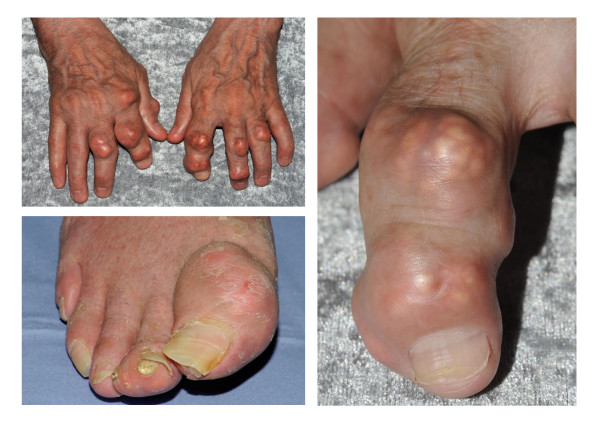Gout

For patient information click here
|
Gout Microchapters |
|
Diagnosis |
|---|
|
Treatment |
|
Case Studies |
|
Gout On the Web |
|
American Roentgen Ray Society Images of Gout |
Editor-In-Chief: C. Michael Gibson, M.S., M.D. [1]; Associate Editor(s)-in-Chief: Cafer Zorkun, M.D., Ph.D. [2] Synonyms and keywords: Urate crystal arthropathy; uric acid crystal deposition in joint; gouty arthritis; podagra
Overview
Historical Perspective
Pathophysiology
Differentiating Gout from other Diseases
Epidemiology and Demographics
Risk Factors
Screening
Natural History, Complications and Prognosis
Diagnosis
The diagnosis of gout is based upon the identification of intracellular monosodium urate (MSU) crystals in the synovial fluid aspirate of an affected joint, under polarizing light microscopy. But when this is not possible, a clinical diagnosis can be deduced with the help of classical clinical features, including the history and physical examination, laboratory findings, and various imaging studies.
Diagnosis of acute gout
- While the favored approach is to find MSU crystals in the synovial fluid aspirate of an affected joint, in clinical practice a crystal evaluation is routinely not done. 21288096 15014182.
- When a patient is presenting with classic symptoms of rapid onset (within 24 hours), podagra, swelling, and erythema, supported by the presence of hyperuricemia, a clinical diagnosis of gout can easily be concluded. 16707533 18299687 25789770
- When an arthrocentesis is done, synovial fluid should be examined readily under routine light and polarizing light microscopy and looked for negatively birefringent needle-shaped MSU crystals. 13773775
- In addition, testing for cell counts with differential, gram staining and culture should also be done on the aspirate.
- The sensitivity of this technique in demonstrating negatively birefringent intra- and extracellular crystals in patients with gout flares is at least 85 percent, and the specificity for gout is 100 percent. 856219 16462524. The sensitivity of can be further improved by examination of the sediment in a centrifuged specimen. 10803751
Diagnosis of intercritical and tophaceous gout
- In patients where a diagnosis of gout wasn’t ascertained during an acute flare, a synovial fluid analysis identifying urate crystals from the previously affected joints would allow a late establishment of the disease.
- Urate crystals are present in synovial fluid of all untreated gouty patients and in approximately 70 percent of those under urate-lowering therapy. 8624633 10577299 444319
- For tophaceous gout, demonstration of urate crystals in aspirates of tophi provides an easy way to confirm the diagnosis 10834006
Clinical diagnosis “rule” for acute gout
- In patients with acute gout where a diagnosis couldn’t be confirmed due to a negative synovial fluid analysis for MSU crystals, a clinical diagnostic approach can be implemented. 20625017
- This approach utilizes a set of clinical parameters with a scoring value. The parameters are derived from history, clinical presentation, and the laboratory findings. 25231179
- This approach has been shown to improve the accuracy of diagnosis without joint fluid analysis of a gout flare in primary care practice settings 20625017
- The model uses seven variables to calculate a total score to distinguish three levels of risk for gout. These are:
- Male sex (2 points)
- Previous patient-reported arthritis flare (2 points)
- Onset within one day (0.5 points)
- Joint redness (1 point)
- First metatarsal phalangeal joint involvement (2.5 points)
- Hypertension or at least one cardiovascular disease (1.5 points)
- Serum urate level greater than 5.88 mg/dL (3.5 points)
- Based upon the total score, patients can be identified as having low (≤4 points), intermediate (>4 to <8 points), or high (≥8 points) probability of having acute gout.
- In patients with an intermediate score (>4 but <8 points), a preliminary diagnosis of gout may be made for the purpose of clinical management based upon a prevalent clinical features favoring gout.
- This diagnostic approach is not recommended for patients presenting with oligoarticular and polyarticular arthritis, as it was developed studying patients with monoarthritis seen by family physicians.
Treatment
A nurse-led protocol with treatment goal of 6 mg/dL was beneficial[2].
Case Studies
Related Chapter
External Links
- "Answers and Questions on Gout". U.S. National Institutes of Health—National Institute of Arthritis and Musculoskeletal and Skin Diseases. September 28th, 2007. Retrieved 2007-08-28. Check date values in:
|date=(help) - "Coffee Consumption and Reduced Gout Risk". Drinking coffee reduces risk of gout in middle age men. U.S. National Institutes of Health. Retrieved 2007-05-25.
References
- ↑ Roddy, Edward (2011). "Revisiting the pathogenesis of podagra: why does gout target the foot?". Journal of Foot and Ankle Research. 4 (1). doi:10.1186/1757-1146-4-13. ISSN 1757-1146.
- ↑ Doherty M, Jenkins W, Richardson H, Sarmanova A, Abhishek A, Ashton D; et al. (2018). "Efficacy and cost-effectiveness of nurse-led care involving education and engagement of patients and a treat-to-target urate-lowering strategy versus usual care for gout: a randomised controlled trial". Lancet. 392 (10156): 1403–1412. doi:10.1016/S0140-6736(18)32158-5. PMC 6196879. PMID 30343856.
Template:Diseases of the musculoskeletal system and connective tissue
ar:نقرس bg:Подагра cs:Dna da:Gigt de:Gicht eo:Podagro fa:نقرس io:Kiragro id:Gout it:Gotta he:שיגדון lb:Giicht ms:Gout nl:Jicht no:Urinsyregikt sk:Dna sr:Гихт fi:Kihti sv:Gikt te:గౌటు